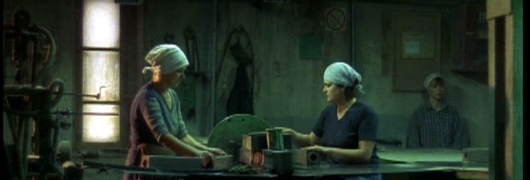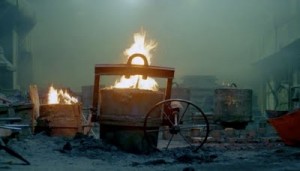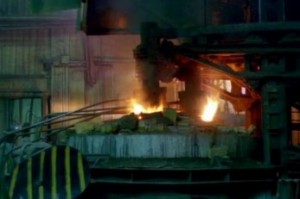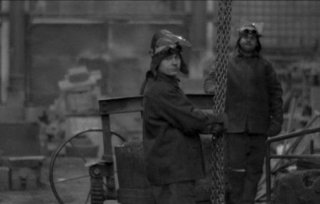Welcome to My Hell: Sergey Loznitsa’s Fabric
The director doesn’t talk, that’s the first thing, the film courses on and he never says a word. And his subjects, the workers of this thirty minute film simply titled Factory, hardly say a word either. In its refusal of language, there is already a narrowing of interests, without having the world named for me; I am forced again to lean on the uneasy resources of my eyes and ears. See for yourself, or rather, see it through his eyes, because this isn’t any factory but one which belongs, for this half hour at least, to Sergey Loznitsa.
There is a shot near the opening which offers me a clue, a way into these foreign spectacles. It shows a beautifully composed, carefully lit building exterior, and just a moment later, after just the right amount of waiting, the first worker arrives, followed by another. I marvel at the choreography, the precise timing, as the windows fill with workers punching their cards before entering the waiting room, the vestibule, of their particular hell, which is also their every day. Now I know for sure that these are also actors, asked to perform what they have rehearsed all too often, and so they bring to this shot all the finesse that Ginger Rogers brings to the dance floor. They appear entirely natural and affectless: cut, print, it’s a wrap.
Already in this documentary we are clearly party to a fictional construction, and I am reminded again of Godard’s injunction: that in order to make documentary, it is necessary to begin with fiction. A hyper fiction then, disguised as a worker’s documentary. There is another aspect of this shot which shines through, its sheer beauty, impossible to ignore in shot after lovely shot, even as these workers shuffle through their endlessly repeating gestures. Beauty is only the beginning of terror, says Breton, but the employees don’t need reminding. They clamber out of dark holes, lift impossibly heavy stones, while I am awed both by the strength of their perseverance (how can they get up every morning to face this?) and by the splendor of their presentation. It’s 35mm baby, bigger than life and a hundred times more beautiful, resurrected from the machine of cinema, married now to the machines of the factory, looking like the worker movies which were going to get a nation over the hump of revolution.
We never learn their names, see their families, learn of their hopes, the way they came here. All that has been left behind, this is not a place but a world, a tautology. Endlessly cruel, the assembly line is always moving, demanding production (keep up, keep going!). The history of these workers has been behind, and in their place the abyss of an endlessly repeating present. A man selects stones from a vast pile and drops it into a pit, again and again. A woman heaves bricks onto a circular conveyer, and then another brick, and then another. One could imagine doing this exactly as long as the shot lasts, and not a moment more, but as the film pushes on past them (though not without looking, letting us feel a little of their hopeless endurance of time) these vignettes of punishment seem like ancient myths come to life. Surely no one lives like this now, not anymore, too busy speeding down the info highway in a globalized, post-mod vehicle which arrives before leaving. As each new view presents itself the memory of the previous shots linger, (Godard: in the cinema we watch a few seconds of what people do all their lives) so each shot never quite manages to displace the next, but offers another variation, a superimposition, a collection which appears all at once.
Refusing the balm of speech, we watch bodies retooled to the rhythm of machines, little more than an extension of the turning pulleys and gears which surround them. And while Loznitsa could have shown us a chronology of manufacture, this is how bricks are made for instance, he deliberately scrambles these gestures, so they appear released from narrative, adrift, isolates vignettes of absurd horror. We are watching through Loznitsa’s careful framing and beautiful lighting, the workings of a factory. But the site is finally unimportant. He could have decided on another subject, someone doing house work for instance, or children returning to school. What he insists upon, first of all, is the view, the frame he uses to apply to these speechless gods, that we are all of us repeating, saying the same thing, fucking the same way (well, it worked last time didn’t it, and the time before that, why not the same again?). Having the same conversation with the same friend, stoking our desire so that possible responses are narrowed. (My attention resembles the funnel of Jihlava, wide in the opening, but finally squeezing everything down to a fine stream, a trickle, where everything appears alike.) After Dante: repetition is hell. After Loznitsa: and hell is all there is. The sum of our hopes, our longings, the forty six summers which are left, the 3000 times we will have to brush our teeth, the stirring of appetites which do not even have the saving grace of belonging to us, but instead are part of someone else’s life, which we rub and chew until it is our life too, the deep grooves worn hard into the body, today and every day, and without end. Finally I have to thank him, this pitiless Russian, for reminding me of the hell I live in, of the hells I like to share with others, but thankful most of all that I am not living there, in that factory. I prefer my first world hells, my familiar hells, to the all too physical punishments carried on now, even now, as these words find their way into our forgetting.
Originally published in: Dok Revue, a newspaper published by Jihlava International Documentary Festival, 2004.



